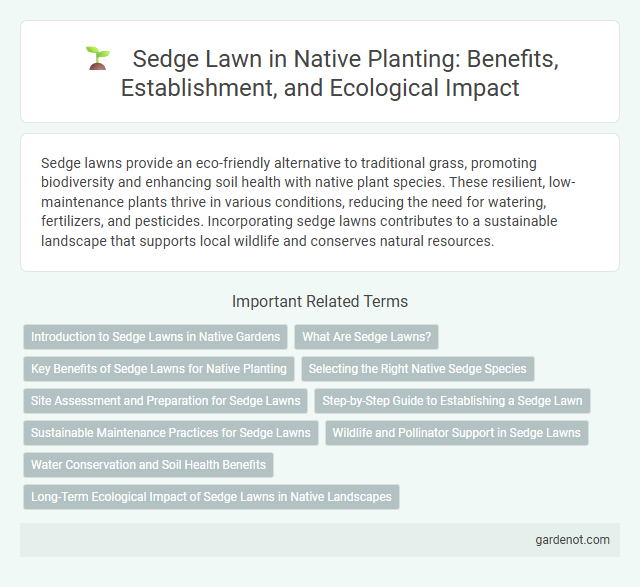Sedge lawns provide an eco-friendly alternative to traditional grass, promoting biodiversity and enhancing soil health with native plant species. These resilient, low-maintenance plants thrive in various conditions, reducing the need for watering, fertilizers, and pesticides. Incorporating sedge lawns contributes to a sustainable landscape that supports local wildlife and conserves natural resources.
Introduction to Sedge Lawns in Native Gardens
Sedge lawns offer a sustainable alternative to traditional grass by utilizing native sedge species that thrive in local climates and require less water and maintenance. These lawns enhance biodiversity, support pollinators, and improve soil health through their deep root systems. Integrating sedge lawns into native gardens promotes ecological balance while providing a resilient and attractive ground cover.
What Are Sedge Lawns?
Sedge lawns consist primarily of native sedge species such as Carex, which offer a sustainable and low-maintenance alternative to traditional grass lawns. These lawns thrive in a variety of soil conditions, including wet or shaded areas where conventional grasses often struggle. Incorporating sedge lawns enhances biodiversity, reduces water usage, and requires minimal mowing, making them an eco-friendly landscaping choice.
Key Benefits of Sedge Lawns for Native Planting
Sedge lawns provide exceptional drought tolerance and require significantly less water than traditional turfgrass, making them ideal for sustainable native planting. Their deep root systems enhance soil stability and promote biodiversity by supporting native insects and wildlife. These lawns reduce the need for chemical fertilizers and pesticides, contributing to eco-friendly landscaping practices.
Selecting the Right Native Sedge Species
Selecting the right native sedge species for a sedge lawn depends on factors like soil type, moisture levels, and sunlight exposure to ensure optimal growth and sustainability. Carex species such as Carex pansa and Carex flacca are popular choices for well-drained, sunny areas, while Carex stricta thrives in wetter, shaded environments. Matching native sedge species to specific site conditions enhances drought tolerance, reduces maintenance, and supports local biodiversity.
Site Assessment and Preparation for Sedge Lawns
Site assessment for sedge lawns requires evaluating soil type, moisture levels, and sunlight exposure to ensure optimal growth conditions. Preparing the site involves removing existing turf, weeds, and debris, followed by loosening the soil to improve aeration and drainage. Proper grading and installation of organic mulch enhance soil stability and promote healthy root development for sedge lawns.
Step-by-Step Guide to Establishing a Sedge Lawn
Prepare the soil by removing existing grass and weeds, then loosen the topsoil to promote root growth. Select native sedge species suited to your region, such as Carex spp., ensuring they thrive in your local climate and soil conditions. Plant sedge plugs or seeds evenly, water consistently during establishment, and mow sparingly to maintain density and prevent weed invasion.
Sustainable Maintenance Practices for Sedge Lawns
Sedge lawns require sustainable maintenance practices such as minimal mowing to preserve their natural structure and reduce carbon emissions. Employing organic mulches and compost enhances soil health while reducing the need for synthetic fertilizers. Regular monitoring for invasive species ensures ecosystem balance and supports biodiversity within the native planting landscape.
Wildlife and Pollinator Support in Sedge Lawns
Sedge lawns provide crucial habitat and nectar sources for diverse pollinators such as bees, butterflies, and moths, enhancing urban biodiversity. These native grasses support ground-nesting birds and small mammals by offering shelter and foraging opportunities. Integrating sedge species into landscapes fosters resilient ecosystems and promotes sustainable wildlife populations.
Water Conservation and Soil Health Benefits
Sedge lawns require significantly less water compared to traditional grass, making them an excellent choice for water conservation in drought-prone areas. Their dense root systems improve soil structure by enhancing aeration and promoting microbial activity, which supports long-term soil health and fertility. These lawns also reduce erosion and runoff, helping to maintain stable soil moisture levels and prevent nutrient loss.
Long-Term Ecological Impact of Sedge Lawns in Native Landscapes
Sedge lawns contribute to long-term ecological resilience by enhancing soil stability and promoting native biodiversity in landscapes. Their deep root systems improve water infiltration and reduce erosion, supporting healthy microbial communities essential for nutrient cycling. Over time, sedge lawns create sustainable habitats for pollinators and wildlife, aligning with native ecosystem restoration goals.
Sedge lawn Infographic

 gardenot.com
gardenot.com